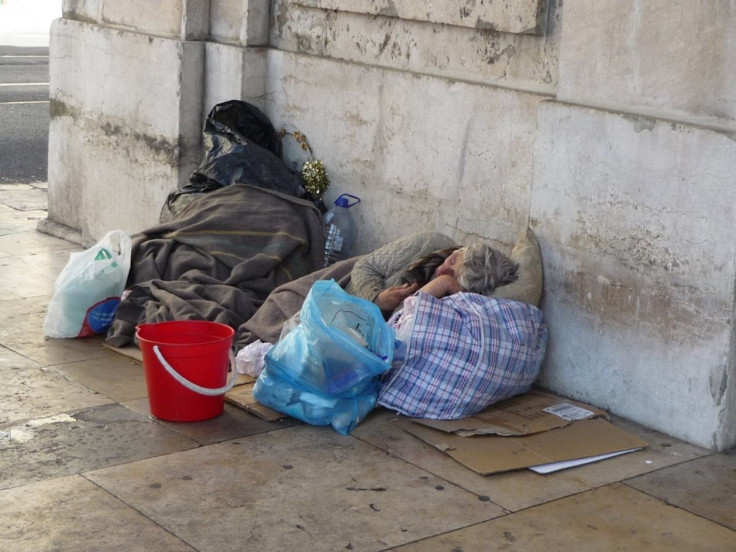Cruel Winter: What NYC Homeless Must Do to Survive

Winter months can be tough. Not only does the temperature drop and nights get long, but the people on the streets must struggle to survive. This week's cold snap means that homeless individuals must take to shelters in order to survive the blistering, freezing cold. And the Bloomberg administration's tough new rules about shelter use aren't making it any easier for those trying to survive out on the streets.
In any case, shelters cannot offer permanent refuge. Because of funding, shelters are designed to be for the sleeping time, said Neil Donovan. Donovan is currently the executive director for the National Coalition for the Homeless. He has been involved in the helping the homeless for 32 years, he said. In the past 26 years, Donovan has held a wide range of positions geared toward helping the homeless. What started as a religious calling, he said, turned into a way of life to help his fellow man.
In October 2011, New York City reached record high for homelessness, the highest level seen since the Great Depression. According to data compiled by the coalition, there were 41,204 people left out on the streets every night, including about 10,000 homeless families and about 17,000 homeless children scattered throughout the five boroughs. Families accounted for nearly 75 percent of the homeless population.
Donovan says shelters are organized in very specific ways. They open their doors around 5 p.m. for homeless individuals to come in and eat dinner. Around 6 p.m., showers and beds open up and usually, said Donovan, they will be in bed by 7 p.m. These shelters accommodate 110,000 different New Yorkers every year.
Unfortunately, most of the large shelters in cities are just funded during that period of time, he said. Around 7 a.m., the shelters must ask the homeless to leave in order to help people with medical issues and to send their staff home.
You are releasing these people at 7 in the morning. What are they are going to do? asked Donovan. He said it is very frustrating for these homeless individuals without a place to stay or direction in their lives.
When you have to do something, you have to do something, when you don't you are stuck in this limbo, Donovan said. That is really a lot of their time, just stuck in this limbo.
They often don't know where to go after they leave the shelter.
The winter just causes more trouble because in a lot of cities you can't take on the behavior of what we call a vagrant, said Donovan. They cannot just sit in a coffee shop or a hang out in store for hours on end.
Many of the homeless work, said Donovan. They work hard, in fact. Many homeless individuals earn spare change from day labor. Others resort to panhandling, which turns into about $33 per four-hour shift, said Donovan. Boredom becomes a fulltime occupation, while making money is only a side job.
So that you are not a nuisance to law enforcement, you stay below the radar, said Donovan, which has a major health impact. That is a real strain on your system.
There are many reasons for homelessness, said Donovan. Most of the problems are difficult to solve. But he was also not hestitant to attack the Bloomberg administration for the rise of homelessness in New York.
Seth Diamond, the commissioner of the city's Department of Homeless Services, is willing to tell a story that is untrue, saying that, in fact, the homeless situation is under control and that it is able to provide enough services and resources, said Donovan.
In recent months, the Bloomberg administration has sought to curtail the shelter population by imposing new policies that will make it harder for the homeless to enter shelters. The policy, which went into effect on Nov. 14, is aimed to save $4 million in homeless services spending.
This policy sets us up to find more people ineligible for shelter, thereby giving the impression that there are less homeless people here, Councilwoman Annabel Palma told International Business Times' Connor Adams Sheets. The way the city calculates the city homeless population, we don't count people that are living on the street, and we don't count people who are ineligible. This policy may sort of blow up in the city's face and end up with more people living on the street.
A call to the Department of Homeless Services went unanswered.
Donovan continued to express his anger at the way the homeless are being treated in New York under the direction of Diamond.
[Mayor Bloomberg] hired someone who had no experiences in homeless services, he said. He makes it sound like it they did it on purpose.
The problem of homelessness is not going away and it is certainly on the rise. Donovan suggests that there must radical changes placed in order to curtail the problems. He suggests investing more money in federal programs. For example, he cited the Homelessness Prevention and Rapid Re-Housing Program, with which his organization was involved. This program helped pay one month's rent to people in danger of losing their homes, or helped people put a deposit down for a rental apartment.
Until more programs like that exist, said Donovan, it is important to commit to safely ensuring that the homeless survive day-to-day.
The important thing that we do is not allow people to spiral down into becoming chronically homeless.
© Copyright IBTimes 2024. All rights reserved.





















